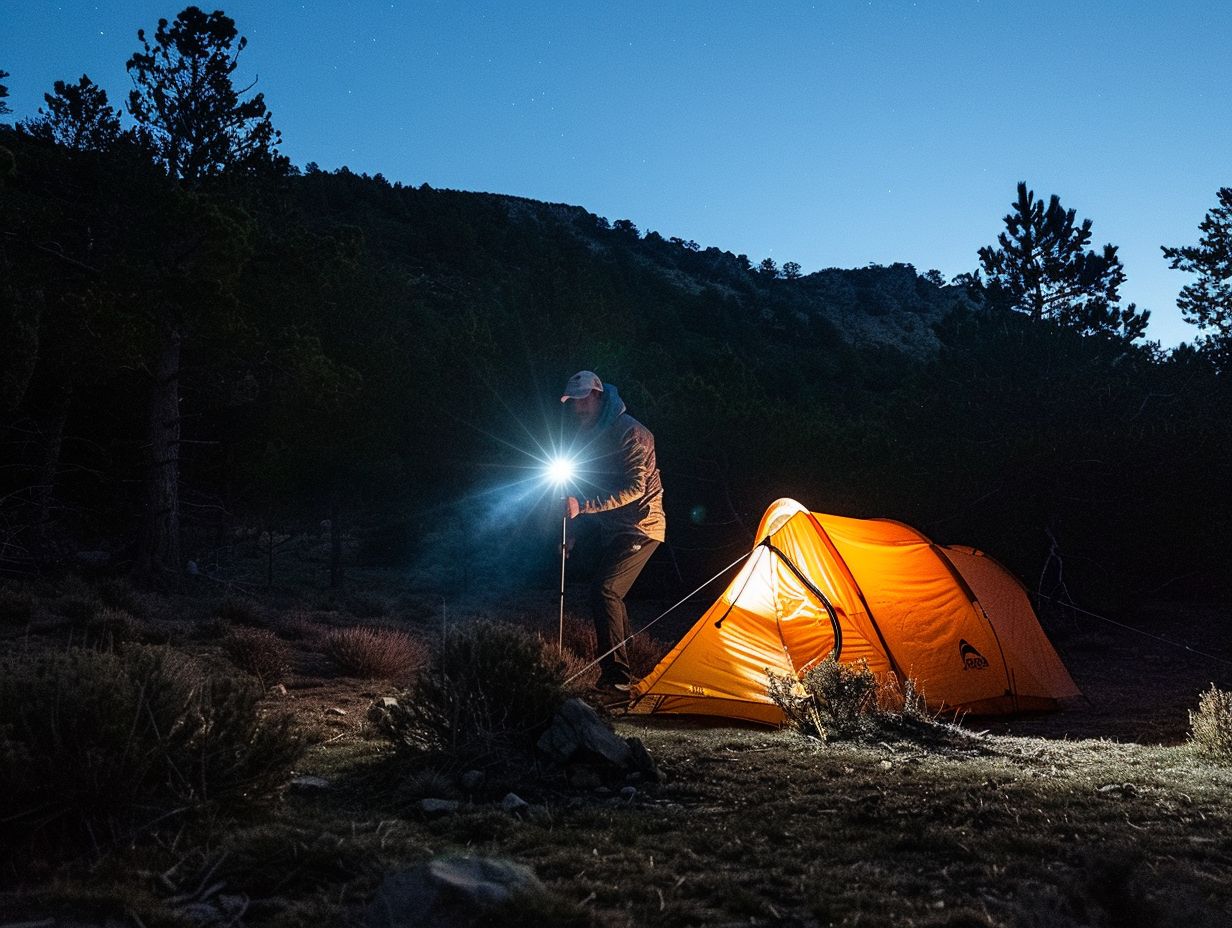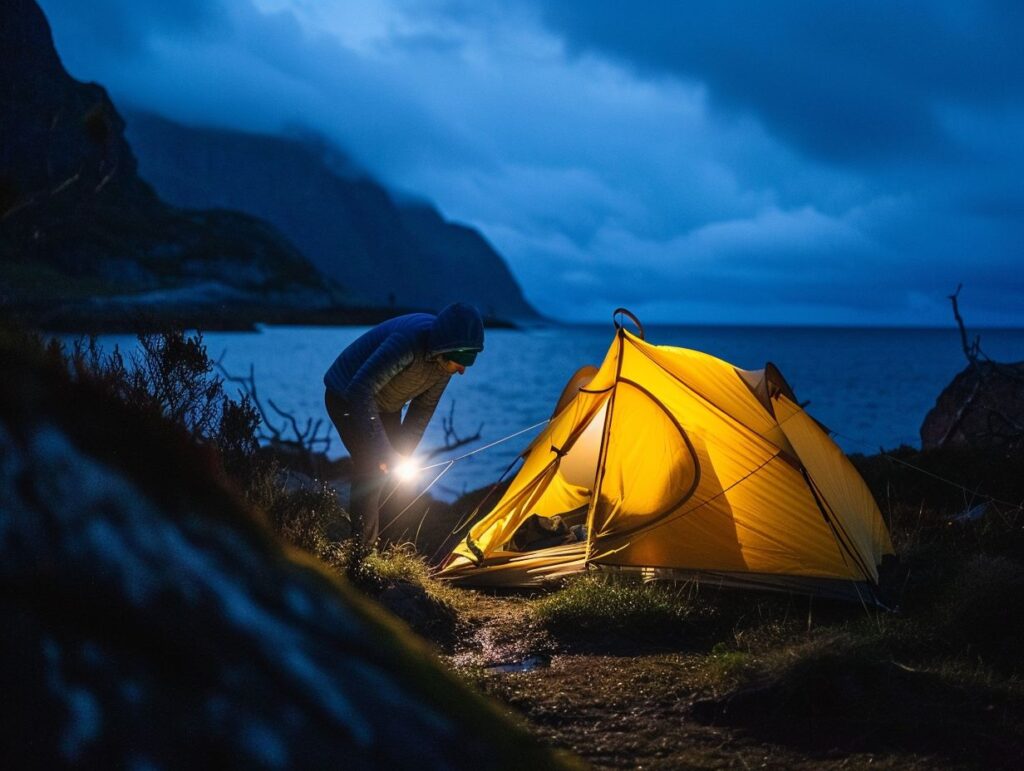Setting up a campsite in the dark may seem daunting, but with the right preparation and know-how, it can be a rewarding experience.
We explore the reasons for arriving at a campsite after dark, what to prepare before your arrival, and essential tips for setting up camp in the dark.
From finding a safe spot to stargazing under the night sky, we guide you through the process of enjoying your nighttime campsite to the fullest.
Grab your flashlight and let’s get started!
Key Takeaways:
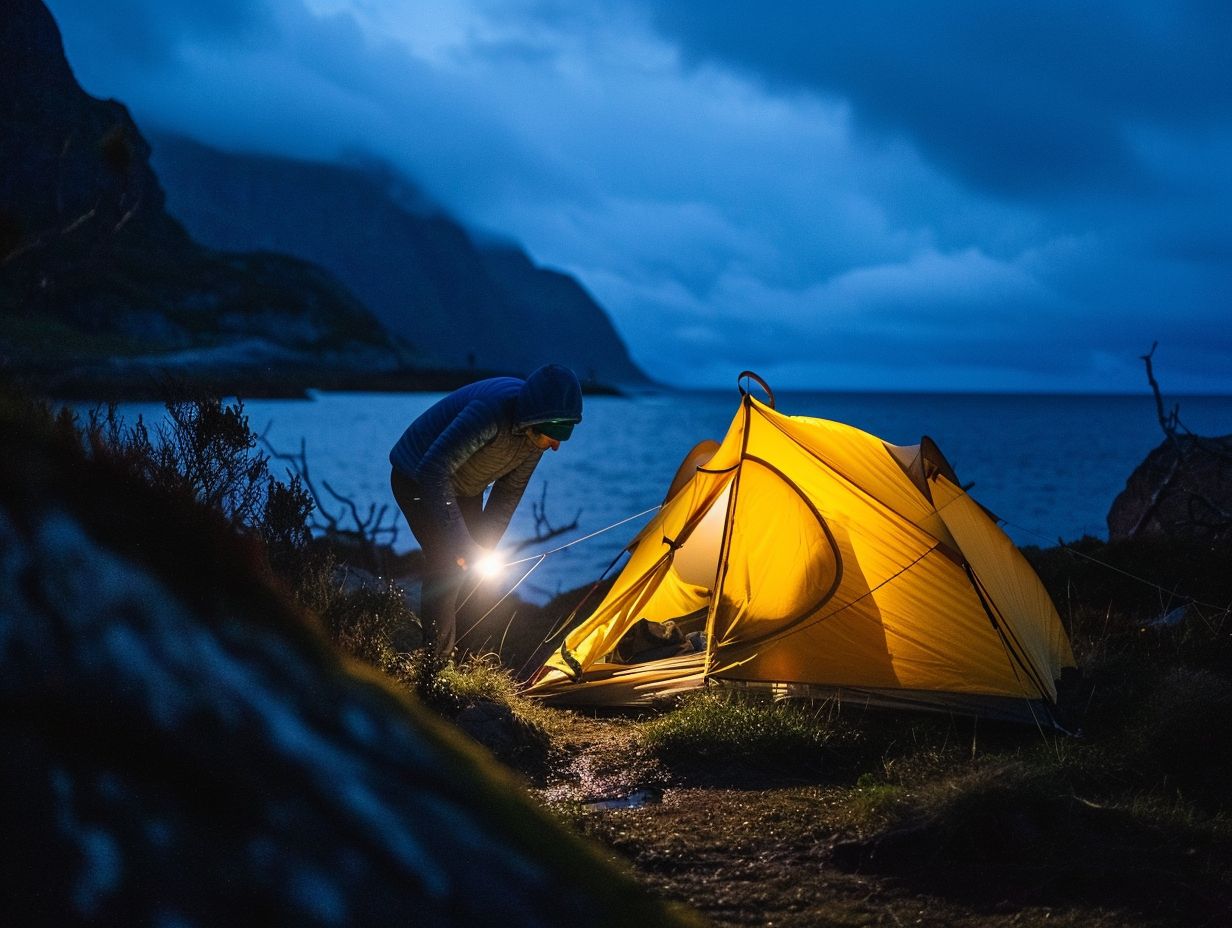
- Plan ahead and be prepared for setting up camp in the dark.
- Make sure to have the necessary equipment, such as a flashlight or headlamp, and a map of the campsite.
- Take precautions, such as finding a safe spot and properly setting up your tent, to ensure a smooth and enjoyable nighttime camping experience.
Why Set Up a Campsite in the Dark?
Establishing a campsite under the cover of darkness may pose challenges, a common reality for many campers who encounter unforeseen delays like traffic congestion or tardy departures from home.
In these circumstances, arriving at the campsite after sunset may be inevitable. While assembling a campsite in dim conditions is less than ideal, it is imperative for campers to be equipped for such eventualities.
Punctual arrival is key, allowing campers to survey the environment, orient themselves with the area, and identify any potential risks. Upon nocturnal arrival, tasks such as erecting tents, arranging sleeping quarters, igniting a campfire, and organising camping supplies may prove more arduous but remain essential for ensuring a comfortable and secure camping expedition.
What to Prepare Before Arriving at the Campsite?
Before reaching the campsite, it is essential to make adequate preparations by assembling all necessary items, which should include a comprehensive map of the campsite. This will facilitate a seamless setup procedure, regardless of the time of arrival.
1. Plan Ahead
Careful preparation plays a crucial role in the success of a camping trip, especially when travelling with children, as it ensures that all planned activities and meals are well-coordinated and prepared in advance.
The strategic planning of meals in advance enables parents to ensure a well-rounded selection of nutritious and varied options while camping. Additionally, this approach allows for the accommodation of any dietary restrictions or preferences that may need to be taken into account.
A detailed itinerary serves to optimise the time allocated to engaging in enjoyable activities and exploration, rather than expending effort on deciding what to do next.
Engaging in practice runs of setting up camp before starting the journey not only ensures a smooth operation but also familiarises children with the camping routine, thus enhancing the overall enjoyment of the experience for all participants.
2. Pack a Torch or Headlamp
It is imperative to include a reliable torch or head torch as part of the essential kit for any camping trip, as it ensures the availability of sufficient lighting for camp setup and navigation within the campsite during nighttime hours.
Additionally, the addition of a lamp can significantly enhance the camping experience. Lamps offer a more extensive and ambient source of illumination, ideally suited for illuminating larger areas such as the campsite surroundings or the interior of a tent.
When multiple light sources are used, they can together create a well-illuminated environment that not only aids practical activities but also enhances the overall safety and enjoyment of nighttime camping activities.
3. Have a Map of the Campsite
It is essential for both RVers and tent campers to have a comprehensive map of the campsite, as it serves as a valuable tool in locating important areas such as parking spaces, entrance gates, and communal facilities.
A map plays a crucial role in facilitating the planning of outdoor activities, enabling campers to optimise their time spent in the wilderness. In the case of RVers, the map can also indicate designated RV sites equipped with appropriate hook-ups, while tent campers can use it to identify optimal tent locations in proximity to facilities such as restrooms and water sources.
Accessing a map can typically be arranged at the campsite office or through online platforms prior to arrival, allowing campers to acquaint themselves with the topography and arrangement of the site before establishing their campsite.
Arriving at the Campsite After Dark
Arriving at the campsite after dark can present a challenging experience, particularly if the campsite gates are closed or if one must be considerate of neighbors who have already settled in for the night.
1. Find a Safe Spot
Upon arrival at the campsite after dark, the first course of action is to identify a secure location to park the vehicle, particularly when dealing with a caravan and needing to identify the designated caravan-only area.
An effective approach to locating a suitable parking space within a campsite involves using a torch to survey the terrain for level ground and any potential obstacles such as rocks or tree roots. It is imperative to adhere to the campsite regulations concerning parking, as these guidelines are established not only to promote safety but also to ensure a positive experience for all campsite visitors.
In the quest for caravan-only locations, individuals should be vigilant in observing signs or markings denoting specific spots reserved for caravans and should strictly comply with these designations to prevent any inconveniences or potential penalties.
2. Set Up Your Tent
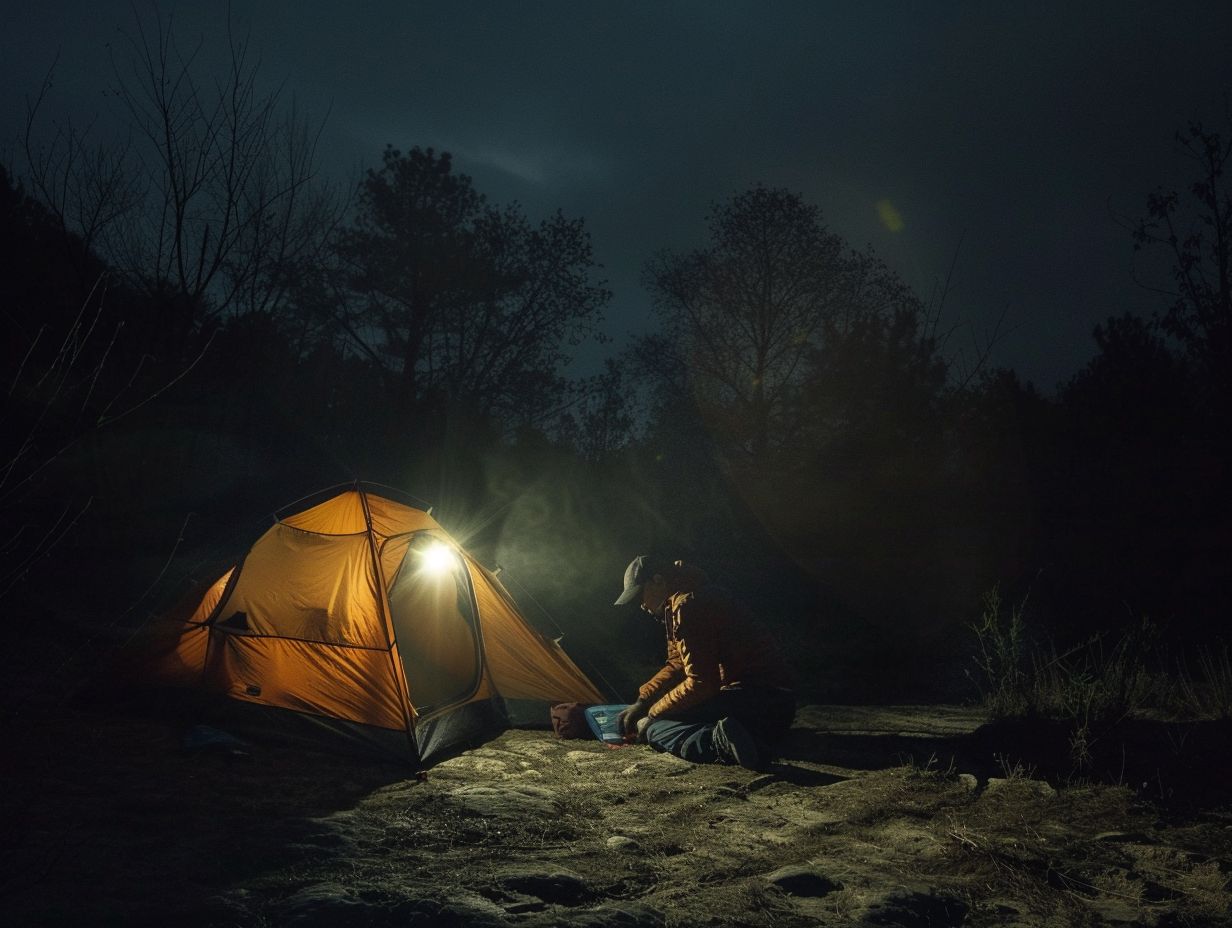
It is important to prioritise setting up your tent as a key task following the securing of your parking spot. This ensures that all essential components are readily accessible, thereby facilitating a streamlined setup process.
To effectively set up your tent, adhere to the following steps:
- Commence by unpacking the tent and laying it out on the ground.
- Proceed to assemble the poles in accordance with the provided instructions.
- Ensure that the corners of the tent are staked down firmly to secure its position.
- Upon completion of the tent structure, affix the rainfly if deemed necessary.
- Arrange your gear, including sleeping bags, mats, and other essentials inside the tent to prevent last-minute scrambling in darkness.
- It is advisable to have a headlamp or torch on hand to enhance visibility during the setup process.
- Before retiring for the night, verify that all zips are closed, and confirm that the tent is securely fastened.
3. Gather Firewood
The procurement of firewood serves as a fundamental task in the preparation of a campsite. A campfire not only offers warmth and illumination but also functions as a central point for evening engagements and social interactions with fellow campers.
To guarantee a secure and pleasant camping experience, adherence to established protocols during the acquisition of firewood is imperative. It is recommended to consult the regulations of the campsite concerning the collection of firewood to evade any potential fines or sanctions.
It is advised to prioritise the utilisation of fallen branches and deceased wood over the cutting of live trees. This practice not only aids in preserving the natural ecosystem but also ensures a sustainable reservoir of firewood for forthcoming campers.
It is essential to display consideration towards other campers by minimising noise levels and disturbances during the gathering of firewood, and it is vital to never leave a fire unattended.
Setting Up Camp in the Dark
Establishing a campsite in low-light conditions can present challenges that are surmountable with adequate preparation and the utilization of appropriate tools, such as a headlamp or torch.
1. Use Your Headlamp or Torch
It is imperative to use your headtorch or torch effectively in order to illuminate your workspace adequately and ensure the safe and efficient completion of necessary tasks.
One strategy for optimising the functionality of your headtorch involves adjusting the angle of the beam to direct the light towards the specific areas where it is most needed. This adjustment can help minimise unnecessary glare and improve overall visibility.
Additionally, leveraging hands-free options like headtorch straps or magnetic mounts can enable you to work on tasks without hindrance while still receiving sufficient illumination. By keeping your headtorch or torch easily accessible, such as by attaching it to your belt or rucksack, you can swiftly retrieve it during emergency situations or sudden alterations in lighting conditions.
2. Follow the Tent Instructions
Adhering to the tent instructions meticulously is imperative for ensuring a successful setup, particularly in low light conditions, as it guarantees that the tent is securely and stably in place for the duration of the night.
Before embarking on a camping expedition, it is prudent to practise assembling the tent at home to acquaint oneself with the process. Commence by organising all components and arranging them methodically to forestall any confusion later on. It is essential to focus on the pole assembly, verifying that each section is connected correctly.
When prepared to set up the tent on-site, select a levelled and unobstructed area devoid of rocks or branches that could potentially puncture the tent floor. It is essential to firmly secure the corners with stakes and utilise guylines for additional stability, particularly during gusty conditions.
3. Secure Your Tent
Ensuring the proper securement of one’s tent is of utmost importance to guarantee safety and comfort throughout the night, particularly in adverse weather conditions such as wind or rain.
- It is essential to position the tent on level ground to mitigate any discomfort during rest.
- Secure the tent corners using durable pegs, driving them into the ground at a 45-degree angle to optimise their grip.
- Attach guy lines to all accessible attachment points on the tent to enhance its support and stability. Properly tightening these lines is crucial to prevent any slack.
- Weatherproof the tent by applying a seam sealer and confirming the adequate fastening of all zips and the fly.
- Ahead of retiring for the night, it is advisable to verify the stability of the tent setup by gently shaking or tugging it, thereby identifying any potential weak points.
Other Tips for Setting Up Camp in the Dark
As well as basic considerations, there are several additional recommendations that can improve the efficiency and safety of setting up a campsite in low light conditions, such as using reflective tape and keeping equipment storage orderly.
1. Use Reflective Tape
The utilisation of reflective tape on camping equipment, including tents, can significantly enhance visibility and mitigate the risk of accidents, facilitating navigation of the campsite during low-light conditions.
It is strongly advised to affix reflective tape not only on tents but also on various gear such as rucksacks, walking poles, and camping chairs. This precaution ensures that these items are easily discernible from a distance, thereby diminishing the likelihood of tripping or collision during nocturnal setups.
For an additional layer of safety, the simultaneous use of lanterns and reflective tape can establish a well-illuminated boundary around the campsite, promoting safe mobility for both individuals within the camp and others in the vicinity.
2. Keep Your Gear Organised
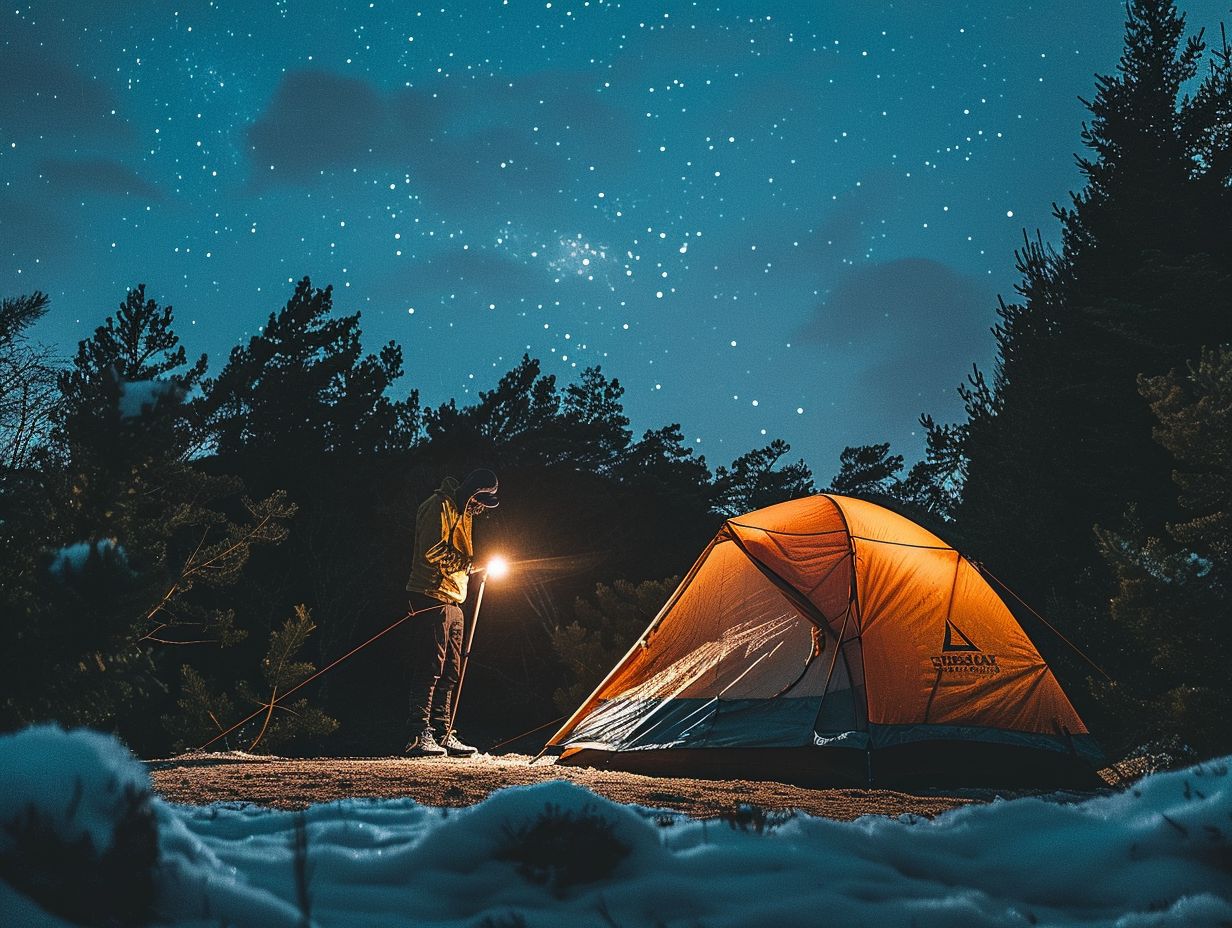
Ensuring the organisation of your equipment is essential for efficient setup and convenient access, especially in low light conditions where identifying specific items can prove challenging.
An effective method to uphold organisation is to utilise labelled containers designated for various types of equipment. By clearly indicating categories such as lighting gear, sound equipment, and cables on the containers, one can promptly pinpoint the required items.
Placing essential items in easily reachable positions within the equipment setup guarantees swift access when needed. This proactive method not only streamlines the setup process but also diminishes the likelihood of misplacing critical gear components amidst time-sensitive situations.
3. Have a Backup Plan
It is advisable to have a contingency plan in place for any camping excursion, as it equips individuals to handle unforeseen circumstances that may arise during nighttime setup activities.
An integral aspect of a well-developed contingency plan is ensuring the availability of alternative lighting sources. It is recommended to include additional batteries for torches or head torches to prevent being caught unprepared in darkness.
In case of unexpected weather shifts, a backup shelter plan can prove invaluable. It is prudent to carry a lightweight tarp or an emergency tent that can be swiftly erected if necessary. Preparedness with these alternatives can significantly enhance the success and enjoyment of the camping experience.
Tips for Enjoying Your Nighttime Campsite
After the successful establishment of the campsite, individuals can proceed to partake in the distinctive night-time camping experiences. These activities may include gathering around the campfire to prepare s’mores or participating in stargazing and other night-time recreational activities.
1. Start a Fire
Initiating a campfire is a customary and pleasant aspect of the camping experience, providing warmth, illumination, and an ideal setting for social interaction with fellow campers and acquaintances.
To ensure the safe and effective establishment of a campfire, it is imperative to begin by selecting a suitable site that is distanced from any flammable materials such as tents or dry grass. The process should involve the collection of firewood in a variety of sizes, ranging from small twigs to larger logs, which should be carefully arranged in either a teepee or log cabin configuration.
Ahead of igniting the fire, it is essential to have a bucket of water or a fire extinguisher in close proximity as a precautionary measure. Adherence to the fire safety regulations of the campsite as well as observing the designated quiet hours for neighbouring campers is obligatory.
By taking these precautions into account, individuals can relish in the tranquil ambiance of a campfire in a responsible manner.
2. Stargaze
Stargazing is an enchanting nocturnal activity that can serve as a valuable educational opportunity for children and a serene recreational pursuit for adults. Contemplating the night sky provides a gateway to the expansive universe, evoking a profound sense of astonishment and curiosity.
This celestial observation not only allows individuals to marvel at the grandeur of the cosmos but also presents an occasion to momentarily escape the frenetic pace of everyday existence. When embarking on a stargazing endeavour, acquiring knowledge about prominent constellations such as Orion and Ursa Major can enrich the experience.
Utilising stargazing applications or guides facilitates celestial navigation and aids in identifying various astronomical marvels, thereby enhancing the engagement and educational value of the stargazing session.
3. Get a Good Night’s Sleep
It is crucial to ensure a good night’s sleep whilst camping to fully enjoy the experience, particularly for parents and children. Establishing a comfortable sleeping environment can greatly contribute to restful nights in the outdoors.
One effective strategy to enhance sleep quality during camping is to thoughtfully select your sleeping arrangements. It is advisable to invest in a high-quality sleeping bag, a comfortable sleeping mat, and, if feasible, a supportive pillow to recreate the comfort of one’s bed at home.
Managing noise levels is also essential. Opting for a peaceful campsite situated away from high-traffic areas can help reduce disturbances. Additionally, bringing earplugs or a white noise machine can assist in minimising disruptive sounds.
To further promote restful sleep, it is recommended to pack essential items such as a warm blanket, a sleep mask to block out light, and a soothing essential oil to facilitate relaxation before bedtime.
Frequently Asked Questions
What are some essential items to bring for setting up a campsite in the dark?
Some essential items to bring include a reliable flashlight or headlamp, extra batteries, a tent with reflective elements, and a camping lantern.
Is it safe to set up a campsite in the dark?
Yes, it can be safe if proper precautions are taken. Make sure to choose a well-lit area, have a light source with you, and be aware of any potential hazards in the surrounding environment.
What are some tips for choosing a campsite at night?
Look for a flat and even surface to pitch your tent, avoid areas with potential hazards such as rocks or roots, and try to set up near a water source and away from noisy areas.
How can I quickly identify my campsite in the dark?
Use reflective tape or markers on your tent, trees, or other objects to help you easily identify your campsite at night. You can also use a unique flag or windsock to mark your spot.
Are there any special techniques for setting up a tent in the dark?
Yes, it’s helpful to practice setting up your tent during the day so you are familiar with the process. You can also use a headlamp or attach a light source to your tent to provide more visibility while setting it up.
What should I do if I get lost while setting up a campsite in the dark?
If you become disoriented or lost, stay calm and use your light source to help you find your way back to your campsite. It’s also a good idea to have a map and compass on hand in case of emergencies.
